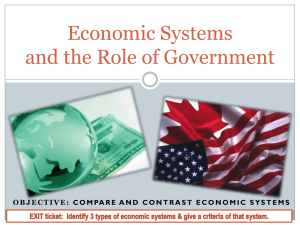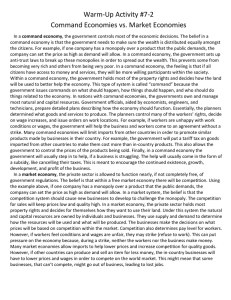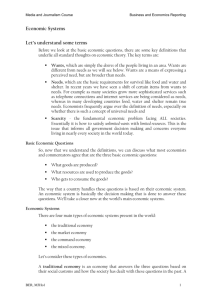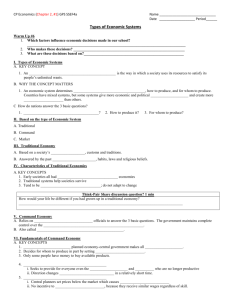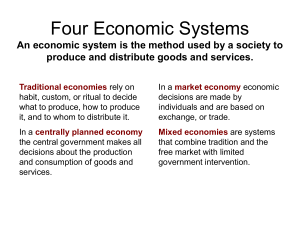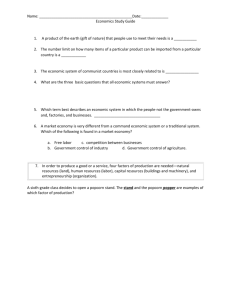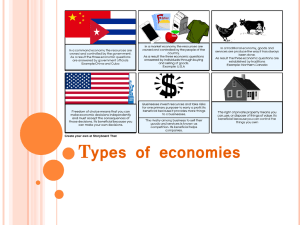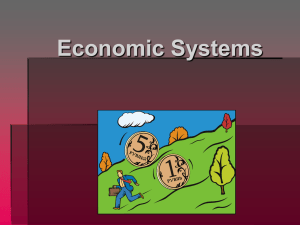Economic Systems Different Economic Systems
advertisement
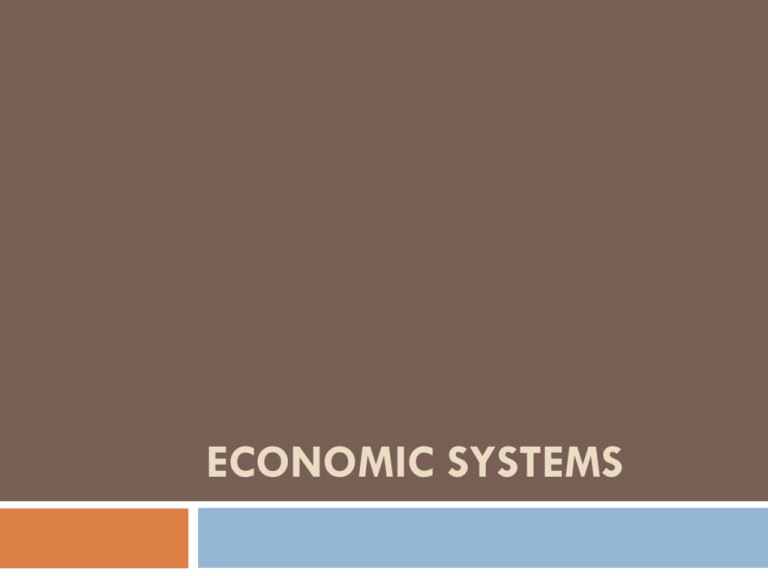
ECONOMIC SYSTEMS Different Economic Systems – Economic Questions WHAT IS ECONOMICS? The study of how resources are managed in the production, exchange, and use of goods and services. Four Types of Economic Systems – 1. Command, 2. Traditional, 3. Market, 4. Mixed Different Economic Systems – Command Economic System The Government decides what goods to produce. The government decides how goods will be produced The government decides how they will be distributed. Today, there are few Command Economies. Perhaps the only examples are the communist countries of Cuba and North Korea. Different Economic Systems – Traditional Economic System A system in which social roles and culture determine how goods are made, sold, and bought. Families, clans or tribes follow customs to meet basic needs. All economic systems have some form of traditional system in them, for example most young people go in to same type of employment as their parents. Different Economic Systems – Market Economic System Economic system based on individual choices and voluntary trade Also known as a free enterprise system Individuals and businesses make economic decisions The market determines the prices and wages People can choose to enter into a business, or they may choose to sell their labor to anyone they want. Consumers are free to spend their money as they wish. Different Economic Systems – Mixed Economies – A mixed economy has features of traditional, command, and market economies. Both the central govt. and the market forces make economic decisions. Most countries today have a mixed economy. Even though the market economy is characterized by competition and freedom, the competition is not perfect and the freedom is not unqualified. Countries with mixed economies try to use the best parts of each system. Different Economic Systems – Mixed Economies – Businesses may still decide what is made, how much things cost, and how much people are paid. The government acts to limit harm that might come from an uncontrolled market economy. For example, the government might establish a minimum living wage. (The U.S. has minimum wages set.) The economy of the U.S. is a mixed economy, but it is still heavily based on the market system. The government plays a smaller role in the U.S. mixed economy. Different Economic Systems – Mixed Economies – Some decisions regarding production. Such as the building of roads, schools, and municipal buildings, are made by federal, state, and local governments. The use of labor in and outside the armed services is determined in part by military authorities. Different Economic Systems – Mixed Economies – Regulated public utilities exist along with unregulated industries; monopolies stand side by side with highly competitive firms; giant corporations compete with small, single proprietorships; the government regulates some industries and not others; and government operations occasionally compete with private industry. Since we have many types of competition and the economy contains both free and regulated markets, it is appropriate to refer to this type of economy as a mixed economy. Examples of U.S. Mixed Economy A central United States bank. Many cities provide public transit as competition against private options, an indirect form of price control. The United States Postal Service is a public mail service that exists alongside private options such as FedEx or UPS. Most road networks are government built and maintained, although private citizens and companies are allowed to "sponsor" a highway or road to ease some of the financial strain. Examples of U.S. Mixed Economy Public and private schools are available for children. Waste collection and treatment are usually provided as a service by the local government, though most local governments pay private companies to perform the service. Examples of U.S. Mixed Economy State and local governments provide guaranteed police and firefighting support, though private security forces are available. Intercity passenger rail (Amtrak) is a nationalized industry, as are many local trains. American airports are government operated but all American airlines are private. The FDA must test and approve a drug or chemical before it is allowed to be sold on the market. Examples of U.S. Mixed Economy State and Federal governments have minimum wage laws, though several occupations are exempt from the rules, such as wait-staff, who make up most of their income from tips. All Americans over the age of 65 are eligible for Medicare, a public health insurance option. Most agriculture has been subsidized. State and local governments provide public utilities such as water, waste, electricity, and internet access.
